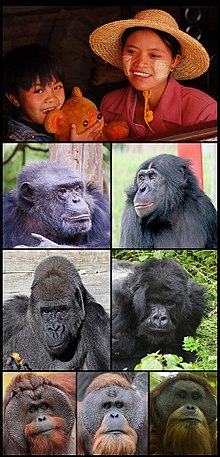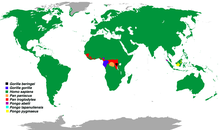วงศ์ลิงใหญ่
| วงศ์ลิงใหญ่[1] ช่วงเวลาที่มีชีวิตอยู่: 17–0Ma สมัยไมโอซีนถึงปัจจุบัน | |
|---|---|

| |
| การจำแนกชั้นทางวิทยาศาสตร์ | |
| โดเมน: | Eukaryota |
| อาณาจักร: | Animalia |
| ไฟลัม: | Chordata |
| ชั้น: | Mammalia |
| อันดับ: | Primates |
| อันดับย่อย: | Haplorrhini |
| อันดับฐาน: | Simiiformes |
| อนุอันดับ: | Catarrhini |
| วงศ์ใหญ่: | Hominoidea |
| วงศ์: | Hominidae Gray, 1825 |
| สกุลต้นแบบ | |
| Homo Linnaeus, 1758 | |
| Subfamilies | |
|
sister: Hylobatidae | |

| |
| กระจายพันธุ์ของวงศ์ลิงใหญ่ | |
| ชื่อพ้อง | |
| |
วงศ์ลิงใหญ่[3] หรือ โฮมินิด (อังกฤษ: Hominid, Great ape) เป็นวงศ์หนึ่งในทางอนุกรมวิธานของสัตว์เลี้ยงลูกด้วยนมในอันดับวานร (Primates) จำพวกเอป หรือลิงไม่มีหาง ใช้ชื่อวิทยาศาสตร์ว่า Hominidae
ซึ่งในปัจจุบันนี้มีดำรงเผ่าพันธุ์อยู่เพียง 4 สกุล คือ Pan, Gorilla, Homo และPongo [1]
ลักษณะสำคัญของวงศ์นี้ คือ มีฟันเขี้ยวขนาดเล็กและอยู่ในระดับเดียวกับฟันอื่น ๆ เดินด้วยขาหลัง 2 ขา เนื่องจากเปลี่ยนวิถีชีวิตจากบนต้นไม้มาสู่พื้นดิน เดิมเคยเชื่อว่าในวงศ์นี้ ประกอบไปด้วยสกุล 3 สกุล คือ Ramapithecus, Australopithecus และ Homo แต่จากการศึกษาเพิ่มเติมพบว่า Ramapithecus มีลักษณะคล้ายลิงอุรังอุตังมากกว่า Australopithecus และHomo จึงจัดให้อยู่ในวงศ์ย่อย Ponginae ของลิงอุรังอุตัง[4]
ในวงศ์นี้ ชนิดที่ทราบว่าสูญพันธุ์ไปแล้วจำนวนหนึ่งถูกจัดกลุ่มกับมนุษย์ในวงศ์ย่อย Homininae ส่วนชนิดอื่น ๆ ถูกจัดในวงศ์ย่อย Ponginae กับลิงอุรังอุตัง บรรพบุรุษร่วมกันหลังสุดของลิงใหญ่เคยมีชีวิตอยู่เมื่อประมาณ 14 ล้านปีก่อน[5] เมื่อบรรพบุรุษของลิงอุรังอุตังวิวัฒนามาจากบรรพบุรุษของอีก 3 ชนิดที่เหลือ[6] บรรพบุรุษของวงศ์ลิงใหญ่ได้วิวัฒนาแยกทางจากวงศ์ Hylobatidae หรือ ชะนี แล้วก่อนหน้านั้น อาจเป็นเมื่อ 15-20 ล้านปีก่อน[6][7]
การจำแนกชั้น แก้
นักวิทยาศาสตร์มีความเห็นไม่ตรงกันในการการจำแนกชั้นของสัตว์ในวงศ์ลิงใหญ่[8] แผนผังด้านล่างแสดงการจำแนกชั้นแบบหนึ่งของไพรเมต/วงศ์ลิงใหญ่ที่ยังมีชีวิตอยู่ เป็นการจำแนกชั้นที่ให้ความสำคัญกับความใกล้เคียงกันทางกรรมพันธุ์ของมนุษย์และลิงชิมแปนซี[9][10][11] โดยมีชื่อตามอนุกรมวิธาน
| Hominoidea (ลิงไม่มีหาง) |
| ||||||||||||||||||||||||||||||||||||||||||||||||||||||||||||
วิวัฒนาการชาติพันธุ์ แก้
ด้านล่างนี้เป็นสายพันธุ์ที่สูญพันธุ์ไปแล้ว ระบุไว้ประมาณล้านปีที่แล้ว (Mya) clades ที่แตกต่างกันไป
| Hominidae (18) |
| |||||||||||||||||||||||||||||||||||||||||||||||||||||||||||||||||||||
ส่วนการจำแนกชั้นมีดังต่อไปนี้ มีการรวมเอาสายพันธุ์มนุษย์ที่สูญพันธุ์ไว้ด้วย ชื่อแรกเป็นชื่อตามอนุกรมวิธาน ชื่อในวงเล็บเป็นชื่อทั่วไป
- วงศ์ย่อย Homininae
- เผ่า Dryopithecini †
- Kenyapithecus
- Kenyapithecus wickeri
- Danuvius
- Danuvius guggenmosi
- Pierolapithecus
- Pierolapithecus catalaunicus
- Udabnopithecus
- Udabnopithecus garedziensis
- Ouranopithecus
- Ouranopithecus macedoniensis
- Otavipithecus
- Otavipithecus namibiensis
- Morotopithecus (ยังไม่สรุป)
- Morotopithecus bishopi
- Oreopithecus (ยังไม่สรุป)
- Oreopithecus bambolii
- Nakalipithecus
- Nakalipithecus nakayamai
- Anoiapithecus
- Anoiapithecus brevirostris
- Hispanopithecus
- Hispanopithecus laietanus
- Hispanopithecus crusafonti
- Dryopithecus
- Dryopithecus wuduensis
- Dryopithecus fontani
- Dryopithecus brancoi
- Dryopithecus laietanus
- Dryopithecus crusafonti
- Rudapithecus
- Rudapithecus hungaricus
- Samburupithecus
- Samburupithecus kiptalami
- Kenyapithecus
- เผ่า Hominini
- เผ่าย่อย Hominina
- Graecopithecus †[12]
- Graecopithecus freybergi
- Sahelanthropus†
- Sahelanthropus tchadensis
- Orrorin†
- Orrorin tugenensis
- Ardipithecus†
- Kenyanthropus†
- Kenyanthropus platyops
- Praeanthropus†[13]
- Australopithecus†
- Paranthropus†
- สกุล Homo (มนุษย์)
- Homo gautengensis†
- Homo rudolfensis†
- Homo naledi†
- Homo habilis†
- Homo georgicus† (บางคนคิดว่าเป็นพันธุ์ย่อยของ Homo erectus )
- Homo floresiensis†
- Homo erectus†
- Homo ergaster† (บางคนถือว่าเป็นชนิดย่อยของHomo erectus )
- Homo antecessor†
- Homo heidelbergensis†
- Homo cepranensis†
- Homo helmei†
- Homo palaeojavanicus†
- Homo tsaichangensis†
- Denisovans (ยังไม่ได้กำหนดชื่อวิทยาศาสตร์)†
- Homo neanderthalensis† (บางครั้งเรียกว่า Homo sapiens neanderthalensis)
- Homo rhodesiensis†
- Homo sapiens
- Homo sapiens idaltu†
- มนุษย์ที่มีกายวิภาคปัจจุบัน,Homo sapiens sapiens
- Archaic Homo sapiens†
- มนุษย์ถ้ำกวางแดง † (ยังไม่มีชื่อวิทยาศาสตร์ อาจจะเป็นเผ่าพันธุ์ของมนุษย์สมัยใหม่หรือลูกผสม[14]ของมนุษย์สมัยใหม่และเดนิโซแวน[15])
- Homo sapiens idaltu†
- Graecopithecus †[12]
- เผ่าย่อย Hominina
- เผ่า Panini
- สกุล Pan (ลิงชิมแปนซี)
- ชิมแปนซี , Pan troglodytes
- ชิมแปนซีกลาง, Pan troglodytes troglodytes
- ชิมแปนซีตะวันตก, Pan troglodytes verus
- ชิมแปนซีไนจีเรียแคเมอรูน, Pan troglodytes ellioti
- ชิมแปนซีตะวันออก, Pan troglodytes schweinfurthii
- โบโนโบ (ชิมแปนซีแคระ), Pan paniscus
- ชิมแปนซี , Pan troglodytes
- สกุล Pan (ลิงชิมแปนซี)
- เผ่า Dryopithecini †
- เผ่า Gorillini
- สกุล Gorilla (ลิงกอริลลา)
- กอริลลาตะวันตก, Gorilla gorilla
- กอริลลาที่ลุ่มตะวันตก, Gorilla gorilla gorilla
- กอริลลาแม่น้ำครอสส์, Gorilla gorilla diehli
- กอริลลาตะวันออก, Gorilla beringei
- กอริลลาภูเขา, Gorilla beringei beringei
- กอริลลาที่ลุ่มตะวันออก, Gorilla beringei graueri
- กอริลลาตะวันตก, Gorilla gorilla
- Chororapithecus † (ยังเป็นที่ถกเถียง)
- Chororapithecus abyssinicus
- สกุล Gorilla (ลิงกอริลลา)
- วงศ์ย่อย Ponginae
- เผ่า Lufengpithecini †
- Lufengpithecus
- Lufengpithecus lufengensis
- Lufengpithecus keiyuanensis
- Lufengpithecus hudienensis
- Lufengpithecus
- เผ่า Sivapithecini†
- Ankarapithecus
- Ankarapithecus meteai
- Sivapithecus
- Sivapithecus brevirostris
- Sivapithecus punjabicus
- Sivapithecus parvada
- Sivapithecus sivalensis
- Sivapithecus indicus
- Gigantopithecus
- Gigantopithecus bilaspurensis
- Gigantopithecus blacki
- Gigantopithecus giganteus
- Ankarapithecus
- เผ่า Pongini
- สกุล Pongo (ลิงอุรังอุตัง)
- อุรังอุตังบอร์เนียว, Pongo pygmaeus
- Pongo pygmaeus pygmaeus
- Pongo pygmaeus morio
- Pongo pygmaeus wurmbii
- อุรังอุตังสุมาตรา, Pongo abelii
- อุรังอุตังตาปานูลี
- อุรังอุตังบอร์เนียว, Pongo pygmaeus
- Pongo hooijeri†
- เผ่า Lufengpithecini †
ดูเพิ่ม แก้
อ้างอิง แก้
- ↑ 1.0 1.1 Groves, C. (2005-11-16). Wilson, D. E.; Reeder, D. M. (บ.ก.). Mammal Species of the World (3rd ed.). Johns Hopkins University Press. pp. 181–184. ISBN 0-801-88221-4.
- ↑ Cameron, D.W. 1997: A revised systematic scheme for the Eurasian Miocene fossil Hominidae. Journal of human evolution, 33: 449–477.
- ↑ หน้า 175, สัตว์สวยป่างาม (สิงหาคม, 2518) โดย ชมรมนิเวศวิทยามหาวิทยาลัยมหิดล
- ↑ วิวัฒนาการของมนุษย์
- ↑ Andrew Hill & Steven Ward (1988). "Origin of the Hominidae: The Record of African Large Hominoid Evolution Between 14 My and 4 My". Yearbook of Physical Anthropology. 31 (59): 49–83. doi:10.1002/ajpa.1330310505.
- ↑ 6.0 6.1 Dawkins R (2004) The Ancestor's Tale.
- ↑ "Query: Hominidae/Hylobatidae". Time Tree. 2009. สืบค้นเมื่อ December 2010.
{{cite web}}: ตรวจสอบค่าวันที่ใน:|accessdate=(help) - ↑ Potts, Richard B. (2006), "Human Evolution", Microsoft Encarta 2006
- ↑ Wood, Bernard; Richmond, Brian G. (2000). "Human evolution: taxonomy and paleobiology". Journal of Anatomy. 197 (1): 19–60. doi:10.1046/j.1469-7580.2000.19710019.x. PMC 1468107. PMID 10999270.
{{cite journal}}: CS1 maint: multiple names: authors list (ลิงก์) Full PDFPDF (1.1 MB) - ↑ Cartmill, M.; Smith, F. He (2011). The Human Lineage. John Wiley & Sons. ISBN 978-1-118-21145-8.[ลิงก์เสีย]
- ↑ Groves, C. P. (2001). Primate Taxonomy. Smithsonian Institution Press. ISBN 1-56098-872-X.
- ↑ Fuss, J; Spassov, N; Begun, DR; Böhme, M (2017). "Potential hominin affinities of Graecopithecus from the Late Miocene of Europe". PLoS ONE. 12 (5): 5. Bibcode:2017PLoSO..1277127F. doi:10.1371/journal.pone.0177127. PMC 5439669. PMID 28531170.
- ↑ "Paleodb". คลังข้อมูลเก่าเก็บจากแหล่งเดิมเมื่อ 2011-07-27. สืบค้นเมื่อ 2020-09-23.
- ↑ Barras, Colin (14 March 2012). "Chinese human fossils unlike any known species". New Scientist. สืบค้นเมื่อ 15 March 2012.
- ↑ "National Geographic". National Geographic Society. คลังข้อมูลเก่าเก็บจากแหล่งเดิมเมื่อ 2007-06-16. สืบค้นเมื่อ 25 July 2009.
แหล่งข้อมูลอื่น แก้
- Renderings of Hominid Exemplars at the Smithsonian เก็บถาวร 2013-12-03 ที่ เวย์แบ็กแมชชีน
- Additional information on great apes เก็บถาวร 2005-08-04 ที่ Library of Congress Web Archives